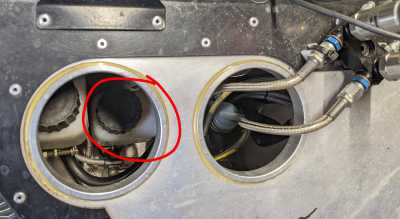
New season prep - what to cover?
I'm going through the lists off the manuals etc... but with a possible first outing at Silverstone next month (i'll see what the forecast is like!), the car will have been parked for 4 months. I've only started it twice in that time.
- with the engine/GDU oil, I put in new fluids before it's last outing in early November, and total on-load time was around 45 mins. Would you bother with new oil? Will both oils still be 'functioning' normally? sorry i know that sounds like such a noob question....if it was a road car i wouldn't even think twice but this is a bit different.
- other than going around with my torque wrench and tightening everything to spec, visual inspection etc....is there anything else you guys would do?
- brake pedal still feels firm but is it worth flushing through and putting in new fluid given that it's been sat for a while?
@rojid, From my understanding your GDU and engine oil will be absolutely fine... no issues unless you have had it sitting in an area where the ambient temperature fluctuates wildly and the relative humidity has been really high for extended periods... and even then any condensate that's collected inside the engine (and probably the GDU) will get hot enough to 'flash off' once the car is fully up to temp and the oil circulates for a few minutes.
I think a as a general rule that the brake fluid should be changed frequently in race cars... at least every 12 months (assuming you might drive the car 4-6 times in that period...)
I would put 500ml through each system (front and rear circuits)... that's what I did in the last season break and it was plenty to make sure the system was completely flushed (visible by the colour change).
I use a vacuum bleeder to do most of the job, and then get a helper in the car to do a final pressure bleed once the system is flushed with new fluid. (just be sure to leave a small amount of new fluid - say at least 50ml for each system to top up the reservoirs after the final pressure bleeding has been completed)
While at it you might also consider re-bleeding your clutch circuit too... although not as critical.
One final thing to note about pressure bleeding the brakes. Whoever is in the car to actuate the brake pedal should also fully depress the clutch pedal before stroking the brake pedal to bleed the brake circuit. The reason for this is that if you don't then the brake pedal, which moves through a much larger stroke range during bleeding than when normally braking, can move so far that the brake bias cable can get bent (it comes into contact with the clutch pedal lever arm). Once the cable is damaged you will forever have trouble using your brake bias adjuster....
Hope that helps...
@rjbender I see 3 resvirors in the front. 1 isn't he clutch fluid, the other 2 is front and rear brakes fluid? So 1 for the front and 1 for the rear and they are separate? I was planning to change brake fluid but couldn't figure out what is what. How do I tell which one is for the front? And the brake and clutch use the same fluid? Thank you.
@pugdaddy - Hi Eddy,
The best way to tell which reservoir is which is to trace the brake line from one of the front calipers to the respective master cylinder/reservoir. Obviously both front calipers will be connected to one system, and the brakes lines that disappear into the sidepod and go to the rear calipers are the other.
Yes - the brake and clutch systems use the same fluid.
Have you had experience bleeding brakes before? If not then I would strongly suggest getting someone who has done it to give you a hand... these aren't the types of cars where you want any brake issues to pop up.
Thank you Rob. Yes I have bleed brake fluid before but all have just one 1 resviror. And I think the radical has 2 bleeding valve/ caliper which I think thebcars that I bleed before only has one.
my reservoir for the front brakes is the right hand side one of the 2 reservoirs. I only know that coz there's a brake line with a label saying 'front brakes' feeding into the bottom of it.
i am curious to know what are those smaller 'pots'? like the one you can see through the right hole of the crashbox.
@rojid ... as I replied to the original post, if your car didn't have any labels (like mine) you can simply follow the brake lines from either of the front calipers to one of the reservoirs.... that will be the front systems master cylinder. The brake lines can be easily seen (they are less than 3 feet away from the master cylinder), Alternatively you could follow the lines from the brake pressure transducers that sit less than 12" away, but mine aren't labelled there either....
I'm not sure what you mean by 'smaller pots' and the photo you supplied looks different to my own right hand drive car. On mine there are two larger reservoirs (mounted on top of the front and rear brake master cylinders) and a smaller one like in your photo for the clutch. The clutch reservoir is smaller as it only need to move one actuator a fairly small distance (clutch slave cylinder bolted on the side of the engine, just in front of the GDU coupling), rather than 4 pistons in each caliper on the front or rear system (total of 8 brake pistons in each front and rear system).
Posted by: @rojid- other than going around with my torque wrench and tightening everything to spec, visual inspection etc....is there anything else you guys would do?
All of the service and pre-race items are well described in the manual, and frankly although there are many thoughtful and experienced members on this forum, when it comes to car prep it is best to follow the detailed service schedule in the manual for your own safety. Never overlook anything and make double certain that everything related to your brake system from master cylinders, hydraulic brake lines, calipers, rotors, pads, etc. are in ideal condition.
That said, I never tighten suspension fasteners to torque specs because the suspension needs to move freely, and the bushings will split or wear out fast if you do tighten to spec. I tighten just barely snug for all bolts that go through a bushing; the nylock nuts, if fresh and not worn, will not loosen, and it would be sufficient put a short wrench on it just to check that it has not backed out and that the nylon material is still providing effective retention. Replace nylock nuts when they lose their retention ability. For bolts like those that are not holding a bushing, such as those that fasten the top/bottom bearing of the shocks, or engine bolts, etc., then torqued to spec won't hurt anything. Generally, I use a wrench and feel. Many torque specs in the Radical Manual are on the over-torqued side and I have stripped threads. The only place I pay close attention to the manual are the ratio nuts in the GDU and the wheel hub nuts. Everything else I do by hand and feel after learning from race team technicians and by my own mistakes. When it comes to steel bolts in tapped aluminum like the main and sub wings, snug is better than tight because these are areas that are easy to over-tighten and strip the threads.
I check all of the body panels and parts for any movement and damage. This is in the manual. Particularly the front splitter -- it should be stiff, not drooping, and the stays straight.
Posted by: @rojid- brake pedal still feels firm but is it worth flushing through and putting in new fluid given that it's been sat for a while?
This may have already been addressed by another post, but it certainly cannot hurt to bleed the brakes as prep for the next event. I rarely do a full flush on my race cars but just bleed about 15-20 cm of fluid through a clear bleeder tube for each bleeder valve. The first few centimeters often show discoloration and some tiny bubbles, and that is all I care about bleeding. For Radical, I bleed about every 4 hours of track time or more frequently if there is any doubt about the feel of the brakes. Because I bleed frequently, in effect the fluid is gradually flushed throughout the season.
@davidf the problem i have with doing it by feel as i'd say i'm below average strength for a 'fit mid 30's male' compared to any of my friends for example, so my version of tight might be someones snug.
That's why i'd rather just do everything via torque wrench. I know the manual lists all the recommended torques for various bolt sizes on page 43 so i'll stick with that.... if a bolt does snap and i end up in a days slog drilling it out slowly then i'll have learnt my lessons on that particular bolt!
noted on the suspension bolts, the torque seal is still in place from over 12 months ago... maybe i use my digital torque wrench adapter to check the break point when it loosens and use that as a guide VS the manual.
I understand. When it comes to torque, using a measuring device and the correct torque spec is far more accurate than "by feel" and descriptions such as "barely snug", "snug", "tight", etc. And for all you know I may be giving out bad advice, so it is safer to follow the user manual written by the manufacture, especially when your health and life is on the line. I use by-feel for daily nutting a bolting the car; the purpose of pre-race/test checklist is to identify loose fasteners and other problems such as damaged body parts, rather than re-torque every accessible fastener to spec. For any replacement or rebuild I take the time to torque to spec. with the exceptions I have already mentioned.
Some of the values in the manual were too high, and it appears that the torque page has been updated recently with corrections. e.g. the disc to hub bolts had a value of 80 ft-lbs and now it says 50 ft pounds. I feel that the 3/8-24 fasteners that support the suspension arms with a bushing should be less than 30 ft-lbs.; my strategy is to use low torque on these and to keep an eye on them throughout the day at the track; I keep a supply of nylock nuts and replace if there is any doubt, or after removing them a few times.
Posted by: @rojid- other than going around with my torque wrench and tightening everything to spec, visual inspection etc....is there anything else you guys would do?
In addition to the service schedule and pre-race checklist, I always do a complete chassis setup before each event.


